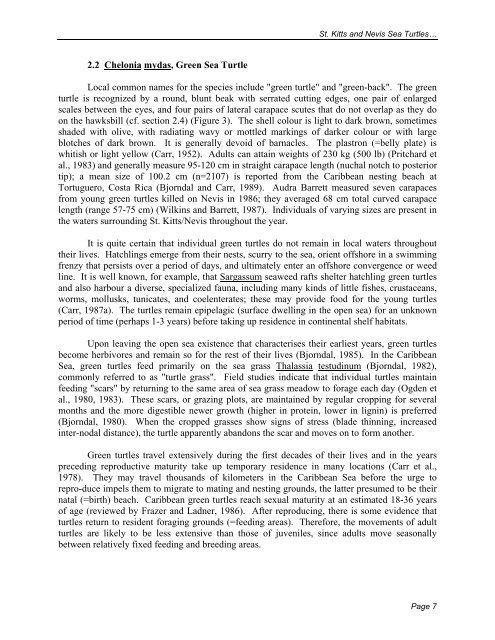Sea Turtle Recovery Action Plan for St. Kitts and Nevis - WIDECAST
Sea Turtle Recovery Action Plan for St. Kitts and Nevis - WIDECAST
Sea Turtle Recovery Action Plan for St. Kitts and Nevis - WIDECAST
You also want an ePaper? Increase the reach of your titles
YUMPU automatically turns print PDFs into web optimized ePapers that Google loves.
<strong>St</strong>. <strong>Kitts</strong> <strong>and</strong> <strong>Nevis</strong> <strong>Sea</strong> <strong>Turtle</strong>s…<br />
2.2 Chelonia mydas, Green <strong>Sea</strong> <strong>Turtle</strong><br />
Local common names <strong>for</strong> the species include "green turtle" <strong>and</strong> "green-back". The green<br />
turtle is recognized by a round, blunt beak with serrated cutting edges, one pair of enlarged<br />
scales between the eyes, <strong>and</strong> four pairs of lateral carapace scutes that do not overlap as they do<br />
on the hawksbill (cf. section 2.4) (Figure 3). The shell colour is light to dark brown, sometimes<br />
shaded with olive, with radiating wavy or mottled markings of darker colour or with large<br />
blotches of dark brown. It is generally devoid of barnacles. The plastron (=belly plate) is<br />
whitish or light yellow (Carr, 1952). Adults can attain weights of 230 kg (500 lb) (Pritchard et<br />
al., 1983) <strong>and</strong> generally measure 95-120 cm in straight carapace length (nuchal notch to posterior<br />
tip); a mean size of 100.2 cm (n=2107) is reported from the Caribbean nesting beach at<br />
Tortuguero, Costa Rica (Bjorndal <strong>and</strong> Carr, 1989). Audra Barrett measured seven carapaces<br />
from young green turtles killed on <strong>Nevis</strong> in 1986; they averaged 68 cm total curved carapace<br />
length (range 57-75 cm) (Wilkins <strong>and</strong> Barrett, 1987). Individuals of varying sizes are present in<br />
the waters surrounding <strong>St</strong>. <strong>Kitts</strong>/<strong>Nevis</strong> throughout the year.<br />
It is quite certain that individual green turtles do not remain in local waters throughout<br />
their lives. Hatchlings emerge from their nests, scurry to the sea, orient offshore in a swimming<br />
frenzy that persists over a period of days, <strong>and</strong> ultimately enter an offshore convergence or weed<br />
line. It is well known, <strong>for</strong> example, that Sargassum seaweed rafts shelter hatchling green turtles<br />
<strong>and</strong> also harbour a diverse, specialized fauna, including many kinds of little fishes, crustaceans,<br />
worms, mollusks, tunicates, <strong>and</strong> coelenterates; these may provide food <strong>for</strong> the young turtles<br />
(Carr, 1987a). The turtles remain epipelagic (surface dwelling in the open sea) <strong>for</strong> an unknown<br />
period of time (perhaps 1-3 years) be<strong>for</strong>e taking up residence in continental shelf habitats.<br />
Upon leaving the open sea existence that characterises their earliest years, green turtles<br />
become herbivores <strong>and</strong> remain so <strong>for</strong> the rest of their lives (Bjorndal, 1985). In the Caribbean<br />
<strong>Sea</strong>, green turtles feed primarily on the sea grass Thalassia testudinum (Bjorndal, 1982),<br />
commonly referred to as "turtle grass". Field studies indicate that individual turtles maintain<br />
feeding "scars" by returning to the same area of sea grass meadow to <strong>for</strong>age each day (Ogden et<br />
al., 1980, 1983). These scars, or grazing plots, are maintained by regular cropping <strong>for</strong> several<br />
months <strong>and</strong> the more digestible newer growth (higher in protein, lower in lignin) is preferred<br />
(Bjorndal, 1980). When the cropped grasses show signs of stress (blade thinning, increased<br />
inter-nodal distance), the turtle apparently ab<strong>and</strong>ons the scar <strong>and</strong> moves on to <strong>for</strong>m another.<br />
Green turtles travel extensively during the first decades of their lives <strong>and</strong> in the years<br />
preceding reproductive maturity take up temporary residence in many locations (Carr et al.,<br />
1978). They may travel thous<strong>and</strong>s of kilometers in the Caribbean <strong>Sea</strong> be<strong>for</strong>e the urge to<br />
repro-duce impels them to migrate to mating <strong>and</strong> nesting grounds, the latter presumed to be their<br />
natal (=birth) beach. Caribbean green turtles reach sexual maturity at an estimated 18-36 years<br />
of age (reviewed by Frazer <strong>and</strong> Ladner, 1986). After reproducing, there is some evidence that<br />
turtles return to resident <strong>for</strong>aging grounds (=feeding areas). There<strong>for</strong>e, the movements of adult<br />
turtles are likely to be less extensive than those of juveniles, since adults move seasonally<br />
between relatively fixed feeding <strong>and</strong> breeding areas.<br />
Page 7
















